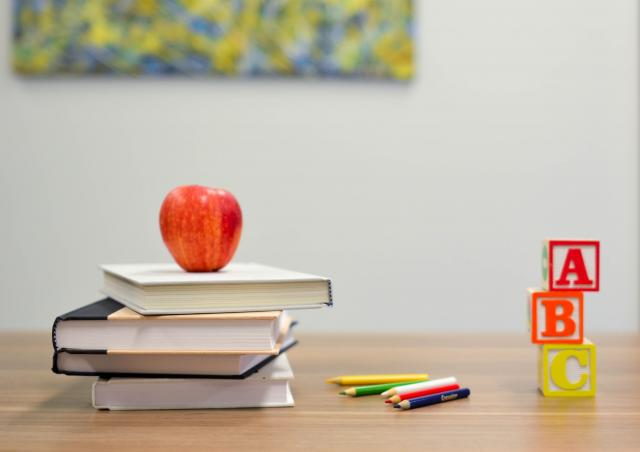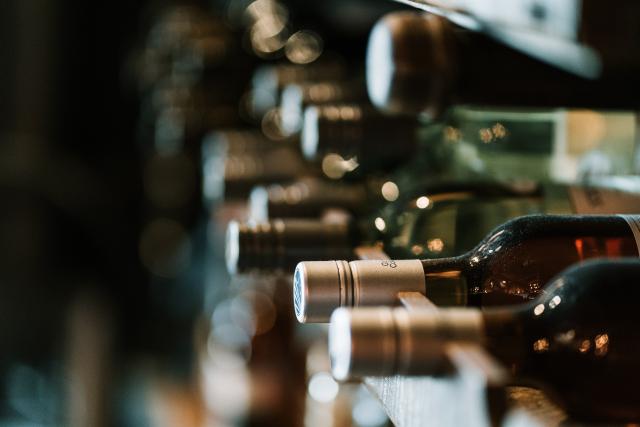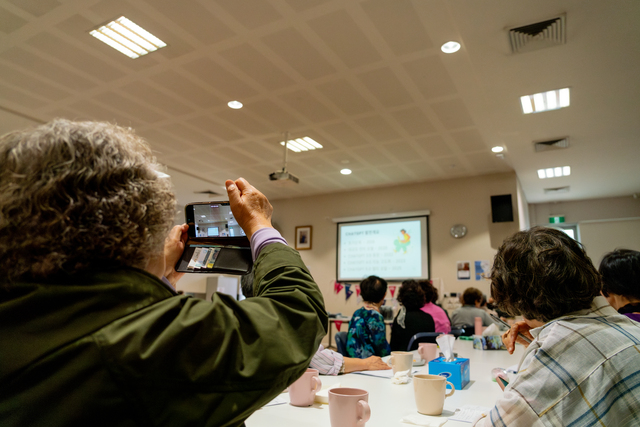Backstage, lights dimmed, the Queensland Performing Arts Centre is full of the haunted emptiness characteristic of public places void of people. In their place are a savannah’s worth of animals, hung on walls and suspended from the ceiling – here a wildebeest, there a gazelle, elsewhere an elephant and its calf.
The effect is curated, almost decorative, enough to carry the cordite tang of a big-game trophy room. But this is no post-colonial hangover – this is the paraphernalia of The Lion King stage show, which will open in Melbourne in this month after completing its Brisbane season.
Slicing through the murk is a lone bright light, coming from the workbench of Sophie Jones, masks and puppets supervisor for the show’s Australian production. Jones is a sunny sort, possessed of a charming Devon lilt and the sort of cascading effervescence normally associated with champagne fountains at weddings.
Arrayed around her are some of the show’s most beloved characters, masks of king Mufasa and his jealous brother Scar. Nearby is a somewhat less regal visage – the hornbill Zazu, the king’s uptight majordomo and a personal favourite of Jones’.
“He’s gorgeous, isn’t he?” she enthuses, the puppet springing to life in her hands. “His neck’s made of a Slinky, the body’s carbon fibre, the legs are foam, the feathers are individually cut and stuck on. There’s not a machine that could do that – everything has to be painted and stitched.”
The various masks and puppets, based on designs created for the original Broadway show first performed 18 years ago, were made in Canada and shipped to Australia for painting and customisation by Jones’ team.
Their good looks belie vast technical and technological sophistication. They are conjured from foam and surgical tubing, there are cranks attached to monofilament and Dacron, motors to give the impression of lunging lions, and thermoplastic contoured to the quirks of each actor’s physiology.
“Every single person’s head is a different shape, so every character and their understudies have to have a mask each,” Jones says.
“Every little element is so much work, and it’s all customised – like hair, for instance, once we’ve made the headcasts, that’s how the actors have to keep their hair for the entirety of the show. They can’t shave it off or grow it long because the mask simply won’t fit.”
While some elements are painted to look like wood, the masks and the puppets are made to be light and flexible rather than robust. This is a boon for actors, but it means that breaks and damage are a daily reality.
“You don’t realise how complicated it is until you start to unravel the mechanisms of everything.”
“I have somebody who is stronger with metal and welding, someone who’s great with sewing and stitching, and I cover carbon fibre and a few other areas. You need to do a little bit of everything, and you do the best that you can with the time that you’ve got! It’s just like a pit stop in the grand prix,” Jones says.
There’s a permanent team of three on duty, with one person in attendance at every performance should emergency surgery be required. Jones, her once-white smock now an unintentional kaleidoscope of colour, has played that part before, but now oversees the workshop. Essentially, she’s gone from being a field medic to running the hospital.
“It’s a joyous department; I enjoy so much of what I do. I was brought up in Devon, in England, in a tiny thatched cottage with my mum, who was an artist, and all we did was paint and make masks and puppets, and that’s all I’ve done since!” Jones says.
“Friday nights in particular were dedicated to that, and I just think, ‘Oh god, how generous’. For her to give up every Friday night – you know, for a single mum – was incredible.”
Jones continued her passion at university, studying everything from art and design via property and photography, as well as prop-making and theatre design. She first worked with The Lion King in 1999, when she opened the show in London’s West End before travelling with it to Australia, Shanghai and South Africa.
She has also run mask and puppetry workshops in India and worked on everything from War Horse to Beauty and the Beast via Billy Elliot. In 2013 she returned for a second stint with the lions.

“I’m really blessed, I’ve worked all over the place and had an incredible time. The beautiful thing about this department is that you’ve never nailed everything. People are coming in, their bodies are different, or you get someone who does something a completely different way,” Jones says.
There has always been a murky relationship between art and commerce, particularly in film, where money spent on marketing has a direct correlation to box-office takes. Converting film to the stage is something else – what is being sold is the experience. You have to attend the theatre to see a show, making them an exercise in perpetuity.
Even then, The Lion King is a different beast. The original film, released in 1994, made more than a billion dollars. And since its 1997 Broadway premiere, the stage version has swollen to 22 productions around the world, which have grossed more than $7.86 billion – more than any other show or film. Like most Disney productions, it is a juggernaut of marketing and merchandising. But here’s the thing – it’s really, really good.
The transition to the stage has done much to correct some of the film’s more egregious oversights. Rafiki, the wise mandrill, is now played by a woman, after the show’s original director Julie Taymor pointed out the lack of leading female characters. The cast is also clearly more diverse than in the film – it’s easy to forget that the choice for the king of all the animals in Africa was one Matthew Broderick. And oh, those puppets and masks.
Watching them on stage or wending their way through the aisles is an experience as surreal as it is elegant, particularly given what Taymor has called an “ironic duality” – the actors are just as visible as their animal accoutrements, and the audience is aware of each.
Cameron Goodall, who plays Zazu, says it’s quite liberating as an actor to have the puppet as an external focus for himself and the audience.
“It’s certainly hard work, but it makes a lot of sense,” he says. “Sometimes I might just be moving the head of the bird, in sharp little movements, but then my legs have to, in some way, emulate the legs of a bird – we’re separate elements, but you get the picture of the two of us together forming the character.
“However many hundred shows in, I’m still discovering new things that the puppet can do.
“It’s testament to how strong the design is, and also how strong the character is, that there’s enough scope there to still be creating new things.”
Jones also pays tribute to the enduring quality of the original designs, created by Taymor for the Broadway production. She picks up a mask of Simba, the king of the lions, now caked in an almost geological layer of makeup from actor Nick Afoa. Turning it over, she lovingly points out the tufts of horsehair, individual teeth, and the abundance of other handcrafted details.
“The sculpt is beautiful. The production was incredibly advanced when they started, and you can see the forethought.
“I couldn’t bear to see him go on stage with a scratch. They become like your family, because you spend so much time working on them.”
The cast, she says, has a “love-hate” relationship with the masks – “They’re not the most comfy things in the world” – and while there is plenty of asking, no one has made off with one just yet.
Jones’ work has taken her all over the world, but she has found a home in Australia courtesy of a backpacking misadventure in Asia 20 years ago.
“I had a broken credit card – I stuck it in my boot before I climbed up a volcano and I forgot to take it out!” she says, bursting into laughter. “I had $100 to my name when I arrived here, so I went to a theatre where Phantom of the Opera was on and left a little note. I started working on it, and stayed the year. And that’s how it all started.”
The finish line, however, is always just over the horizon. By now stagehands and managers are scurrying about, and classical music creeps from the speakers, a sound check for the day’s matinee performance. In the workshop, TWR’s photographer is busy moving masks about in a quest for the perfect shot.
And Jones? She’s utterly oblivious to the activity, biting her lower lip in concentration as she carefully paints a pair of replacement hands for the Timon puppet. There’s always just one more thing to do.

The Lion King
» The Lion King runs from February 19-June 28 at the Regent Theatre, Melbourne. www.ticketmaster.com.au







